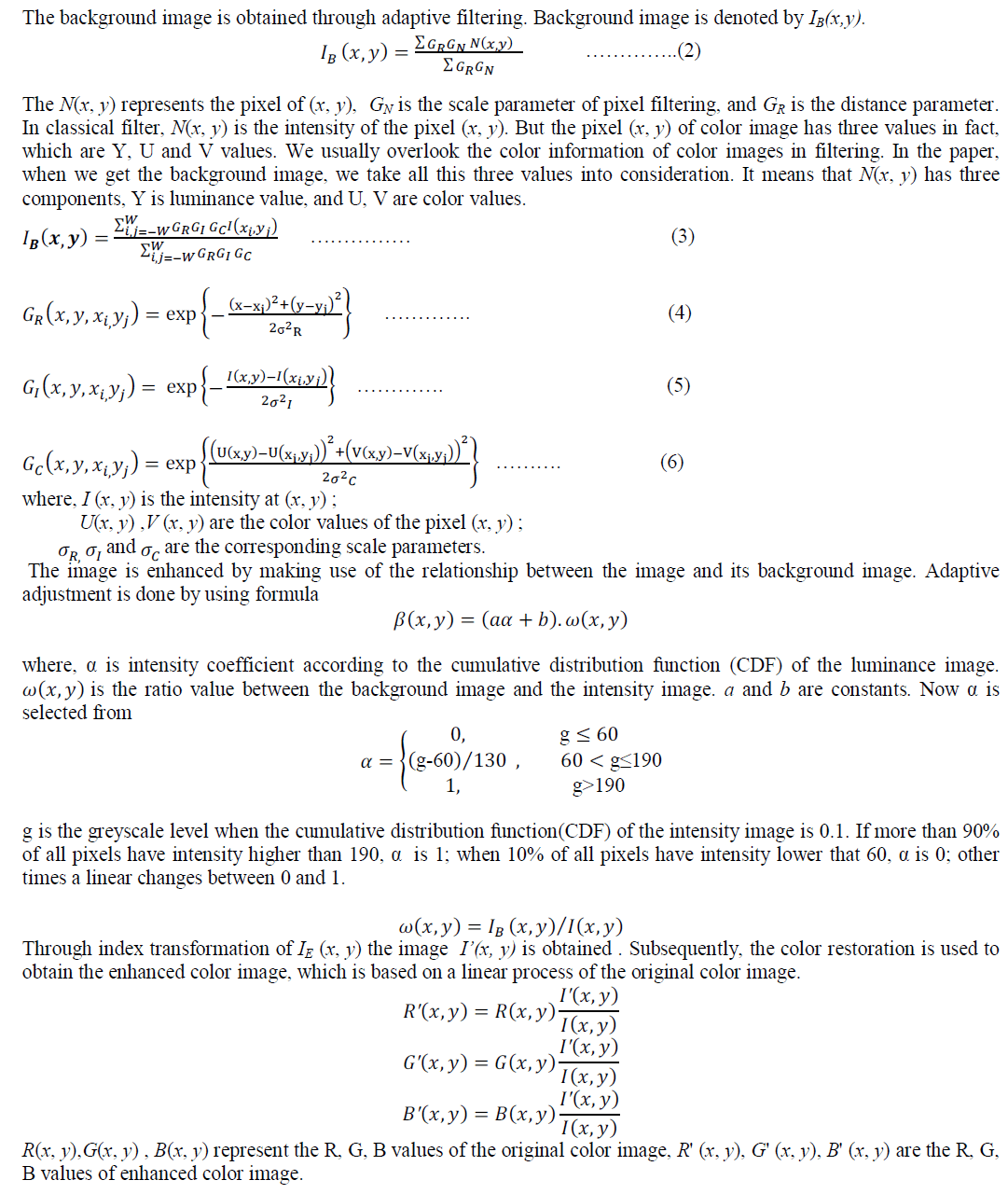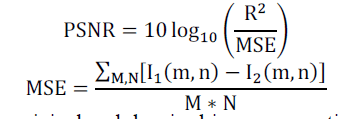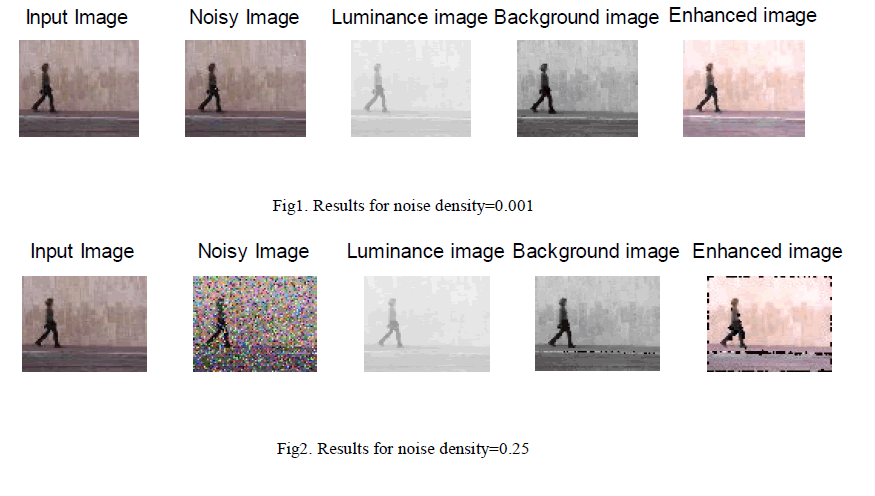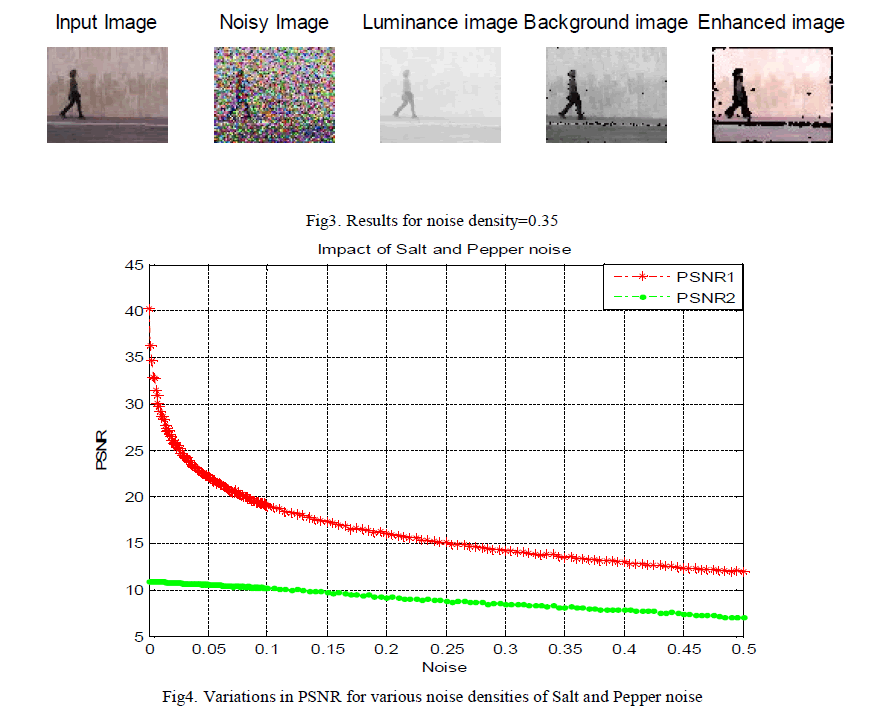ISSN ONLINE(2319-8753)PRINT(2347-6710)
ISSN ONLINE(2319-8753)PRINT(2347-6710)
P.R.Pawar1 and Dr. V.V.Patil2
|
| Related article at Pubmed, Scholar Google |
Visit for more related articles at International Journal of Innovative Research in Science, Engineering and Technology
In this paper, evaluation of HVS based image enhancement technique is done. This algorithm uses human visual system based adaptive filter for enhancing color image. It not only enhances color image but also eliminates salt and pepper noise. This paper reveals how this enhancement technique enhances color image as well as removal of speckle noise from the digital images. Quantitative measures are done by using peak signal to noise ration Experimental results show that salt and pepper noise is removed to much extent without incorporating any explicit denoising technique while enhancing color image by using HVS based adaptive filter.
Keywords |
| Color image enhancement, Human visual system, Salt and pepper noise, PSNR. |
INTRODUCTION |
| Image enhancement is basically improving the interpretability or perception of information in images for human viewers and providing `better' input for other automated image processing techniques. The principal objective of image enhancement is to modify attributes of an image to make it more suitable for a given task and a specific observer. During this process, one or more attributes of the image are modified. The choice of attributes and the way they are modified are specific to a given task. Moreover, observer-specific factors, such as the human visual system and the observer's experience, will introduce great deal of subjectivity into the choice of image enhancement methods. There exist many techniques that can enhance a digital image without spoiling it. The enhancement methods can broadly be divided in to the following two categories as in [1]: |
| 1. Spatial Domain Methods |
| 2. Frequency Domain Methods |
| In spatial domain techniques, we directly deal with the image pixels. The pixel values are manipulated to achieve desired enhancement. In frequency domain methods, the image is first transferred in to frequency domain. It means that, the Fourier Transform of the image is computed first. All the enhancement operations are performed on the Fourier transform of the image and then the Inverse Fourier transform is performed to get the resultant image. These enhancement operations are performed in order to modify the image brightness, contrast or the distribution of the grey levels. As a consequence the pixel value (intensities) of the output image will be modified according to the transformation function applied on the input values. |
Image noise |
| Noise means unwanted signal. Image noise means signals or any random (not present in the object imaged) variation of brightness or color information in images. It is mainly electronic noise. Sources of image noise are circuitry of scanner sensor or digital camera. The magnitude of image noise can range from almost spots on a digital photograph taken in good light, to images that are almost entirely noise, from which it is difficult to extract even small amount of information. This means that a noise level that would be totally unacceptable in a photograph since it would be impossible to determine even what the subject was. |
| Types of image noises: |
| 1. Salt and pepper noise |
| 2. Gaussian noise |
| 3. Speckle noise |
| 4. Poisson noise |
1. Salt and pepper noise |
| Salt and Pepper noise is also known as Impulse Noise or Spike noise. This noise can be caused by sharp & sudden disturbances in the image signal. It represents itself is randomly occurring white or black (or both) dots over image. An image containing salt-and-pepper noise will have dark pixels in bright regions and bright pixels in dark regions. It may occur during image acquisition, due to switching, sensor temperature. It may also occur due to interference in the channel and due to atmospheric disturbances during image transmission. For experimental anlyis purpose this noise can be added in image. An effective noise reduction method for this type of noise is a median filter or a morphological filter. For reducing either salt noise or pepper noise, but not both, a contraharmonic mean filter can be effective. This noise arises in the image because of sharp and sudden changes of image signal. |
2. Gaussian noise |
| Gaussian noise is also known as Amplifier Noise. This noise model is additive in nature and follow Gaussian distribution. Meaning that each pixel in the noisy image is the sum of the true pixel value and a random, Gaussian distributed noise value. It is an idealized form of white noise, which is caused by random fluctuations in the signal. In color cameras where more amplification is used in the blue color channel than in the green or red channel, there can be more noise in the blue channel. Amplifier noise is a major part of the noise of an image sensor, that is, of the constant noise level in dark areas of the image. In Gaussian noise, each pixel in the image will be changed from its original value by a (usually) small amount. The noise is independent of intensity of pixel value at each point. |
 |
3. Speckle noise |
| Speckle is a granular noise that inherently exists in and degrades the quality of the images. This noise can be modeled by random value multiplications with pixel values of the image and can be expressed as |
| J = I + n*I |
| Where, J is the speckle noise distribution image, I is the input image and n is the uniform noise image by mean o and variance v. This noise deteriorates the quality of active radar and Synthetic aperture radar (SAR) [4] images. This noise is originated because of coherent processing of back scattered signals from multiple distributed points. In conventional radar system this type of noise is noticed when the returned signal from the object having size less than or equal to a single image processing unit, shows sudden fluctuations. Mean filters are good for Gaussian noise and uniform noise. |
4. Poisson noise |
| Poisson or shot photon noise is the noise that can cause, when number of photons sensed by the sensor is not sufficient to provide detectable statistical information. This noise has root mean square value proportional to square root intensity of the image. Different pixels are suffered by independent noise values. At practical grounds the photon noise and other sensor based noise corrupt the signal at different proportions. |
RELATED WORK |
| In early researches there were several attempts on color image enhancement. Meylan and Susstrunk had proposed algorithm based on retinex technique[3]. This is effective technique for color image enhancement. This system is to mimic the processing of the human visual system on a scene to render high dynamic range images. Retinex theory intends to explain how the visual system extracts reliable information from the world despite changes of illumination. But the enhanced image has color distortion and calculation is complex. |
| Ghimire and Lee, proposed a method for enhancing the color images based on nonlinear transfer function and pixel neighbourhood by preserving details[4]. In this method, the image enhancement is applied only on the V (luminance value) component of the HSV color image and H and S component are kept unchanged. ZhengyaXu, et all introduced a new hybrid image enhancement approach driven by both global and local processes on luminance and chrominance components of the image[5]. This approach, based on the parameter-controlled virtual histogram distribution method, can enhance simultaneously the overall contrast and the sharpness of an image. The approach also increases the visibility of specified portions or aspects of the image whilst better maintaining image colour. Wang Shou-jue, et all had proposed new algorithm [6]. The algorithm is based on bilateral filter and has much better effect than the above mentioned two algorithms. However, the image still exhibits halo phenomenon at the edges in spite of the algorithm improving it. In, distance and luminance information of pixels are considered in the bilateral filter instead of only considering distance information in Gaussian filter. But the color information is still not taken into consideration. |
| All the methods discussed above are color image enhancement methods but in these methods noises in image are not considered. Some research work was done to remove various types of noises while enhancing color image. It includes work done by M. Mansourpour , M.A. Rajabi , J.A.R. Blais forreduction of speckle noise[7].Reduction of speckle noise is one of the most important processes to increase the quality of radar coherent images. Image variances or speckle is a granular noise that inherently exists in and degrades the quality of the active radar and SAR images. Before using active radar and SAR imageries, the very first step is to reduce the effect of Speckle noise. Most of speckle reduction techniques have been studied by researchers; however, there is no comprehensive method that takes all the constraints into consideration. Filtering is one of the common methods which is used to reduce the speckle noises. This paper compares six different speckle reduction filters quantitatively using both simulated and real imageries. The results have been presented by filtered images, statistical tables and diagrams. Finally, the best filter has been recommended based on the statistical and experimental results. |
| Mr. Rohit Verma Dr. Jahid Ali thrown light on some important type of noise and a comparative analysis of noise removal techniques in[8]. This paper presents the results of applying different noise types to an image model and investigates the results of applying various noise reduction techniques. Rajib Kumar Jha, Rajlaxmi Chouhan, P. K. Biswas proposed a nonlinear non-dynamic stochastic resonance-based technique for enhancement of dark and low contrast images[11]. A low contrast image was treated as a subthreshold signal and noise-enhanced signal processing was applied to improve its contrast. The proposed technique uniquely utilized the addition of external noise to neutralize the effect of internal noise (due to insufficient illumination) of a low contrast image. Random noise was added repeatedly to an image and was successively hard-thresholded followed by overall averaging. By varying the noise intensities, noise induced resonance was obtained at a particular optimum noise intensity. Performance of the proposed technique had been investigated for four types of noise distributions - gaussian, uniform, poisson and gamma. Quantitative evaluation of their performances had been done in terms of contrast enhancement factor, color enhancement and perceptual quality measure. Sudharsan Parthasarathy, Praveen Sankaran proposed that a fusion based approach on Multi Scale Retinex with Color Restoration(MSRCR) would give better image enhancement[10]. Lower dynamic range of a camera as compared to human visual system causes images taken to be extremely dependent on illuminant conditions. MSRCR algorithm enhances images taken under a wide range of nonlinear illumination conditions to the level that a user would have perceived it in real time. One of the enhancement techniques that try to achieve color constancy is Retinex. In Multi Scale Retinex(MSR),they average multiple SSR(Single Scale Retinex) images to obtain a net improved image. |
TECHNIQUE IMPLEMENTED |
| There are many methods available for gray image enhancement but it is not suitable to directly use gray image enhancement technologies for color images. In [2] new algorithm is proposed using adaptive filter. The algorithm consists of three major parts: (1) obtain luminance image and background image, (2)adaptive adjustment, (3)color restoration. |
| First part of implementing this algorithm is to obtain luminance image. The color images we usually see are mostly in RGB color space, which employ red, green, and blue three primary colors to produce other colors. In RGB color space, other colors are synthesized by three primary colors, which is not effective in some cases. Consequently, we use another color space YCbCr. If we remove color components from image then original image will become gray image. Therefore intensity of pixel at (x,y) is luminance value at point. The luminance image of the original color image is IL(x,y). Subjective luminance is the logarithmic function of the light intensity into human eyes. Logarithmic function of the original luminance image is obtained and then normalized it to get the subjective luminance |
 |
 |
EXPERIMENTS |
| Using the algorithm proposed in the paper, color image is enhanced. Experiments are done by adding salt and pepper noise in the input image. Proposed algorithm is then applied on noisy image and image is enhanced. Experiments are done by adding salt and pepper noise with various noise densities. In this algorithm, there is no any separate denoising technique is added but same enhancement algorithm is tested for various densities of salt and pepper noise. For experimental purpose noise densities are added from 0.001 to 0.5. Results are compared by observing parameter PSNR. For the objective estimation peak signal to noise ratio is used to assess enhanced images. |
 |
| Where I1(m,n) and I2(m,n) represent the original and denoised image respectively*N size of enhanced image. R is the maximum fluctuation in the input image data type. For example, if the input image has a double-precision floatingpoint data type, then R is 1. If it has an 8-bit unsigned integer data type, R is 255. |
RESULTS |
| Here, results are compared by calculating PSNR twice. First PSNR is calculated between input image and noisy image. This is referred as PSNR1. Second PSNR is calculated for enhanced image and noisy image. This is referred as PSNR2. |
| Results are taken by varying noise density of salt and pepper noise from 0.001 to 0.5. For minimum noise density results are shown in fig1. In this case image is enhanced and salt and pepper noise gets eliminated. At noise density 0.25, as in Fig.2, proposed image enhancement process gives enhanced image. Though black spots are developed, image intelligence is good. Salt and pepper noise is eliminated with giving good perception of information in images. In fig.3 , as noise density reaches 0.35, salt and pepper noise gets eliminated but image intelligence gets affected. So it can be concluded this algorithm gives good results upto noise density 0.35. |
 |
 |
| It is observed from graph shown in fig.4, that for minimum noise level difference between PSNR of input image and enhanced image with noisy image is high. PSNR1 is peak signal to noise ratio of input image and noisy image. PSNR1 starts dropping as noise density is increased. PSNR2 is peak signal to noise ratio of enhanced image and noisy image. Though PSNR2 is low as compared to PSNR1, drop in PSNR2 is less than PSNR1. |
DISCUSSION AND FUTURE SCOPE |
| In this paper, we have discussed salt and pepper noise that creep in images and affect image intelligence. Algorithm discussed here not only enhances color image but also helps in reduction of salt and pepper noise up to much extent without using any additional method for image denoising. Human visual system based adaptive filter enhances color image. PSNR1 is peak signal to noise ratio between input image and noisy image while PSNR2 is peak signal to noise ratio of enhanced image and noisy image. Drop in PSNR1 is very high as compared to PSNR2 as noticed from slope in graph. Though there is drop in PSNR2, it is lower in rate as noticed with lesser slope. Difference between PSNR1 and PSNR2 is higher for lower noise levels but this difference reduces further. For noise densities of 0.25 and 0.3 onwards difference is very less. Thus enhancement of image having salt and pepper noise is achieved without incorporating any explicit denoising technique. In this paper impact of salt and pepper noise on human visual system based adaptive filter technique for color image enhancement is studied. This work can be extended for studying role of Human visual system based adaptive filter algorithm for Gaussian noise and Speckle noise. |
References |
|